Optimal Water Resources Regulation for the Pond Irrigation System Based on Simulation—A Case Study in Jiang-Huai Hilly Regions, China
Abstract
1. Introduction
2. Study Area
3. Method
3.1. SCS Model-Based Rainfall Runoff Simulation for the Pond Irrigation System
3.2. Water Allocation Simulation of the Pond Irrigation System
3.2.1. Water Resources Structure of a Pond Irrigation System
3.2.2. Water Balance Equations for Basic Elements in Various Computing Units
3.2.3. Operational Rules for the Pond Irrigation System Water Allocation Simulation Model
3.2.4. Development of the Water Allocation Simulation Model for the Pond Irrigation System and Parameter Calibration
- (1)
- Several field surveys were conducted. The results were combined with results from crop irrigation experiments conducted by the Water Resources Research Institute of Anhui Province and Huaihe River Commission in the Jiang-Huai hilly regions over the years with technical service experience in agricultural irrigation. At present, the staple crop of Badou Town is rice. Due to the basic properties of rice, conventional broad irrigation is primarily used. For dry crops, supplementary seedling-preservation irrigation is typically used. The conventional irrigation method in this district was quantified as follows. ① For rice, if there is available water in the water source for irrigation, “flood irrigation” is used; if the water depth of the rice field is zero (i.e., hc = 0 mm), rice is irrigated until the water depth of the field reaches 50 mm. ② For dry crops, if there is available water in the water source and the dry crops are subject to drought stress (i.e., the average soil moisture at the depth of 0~40 cm is less than 50% of the soil field capacity) for 5 d, supplementary seedling-preservation irrigation is used until the average soil moisture at 0~40 cm depth reaches 90% of soil field water capacity. ③ The storage depth threshold of this district was set to be the same as the upper limit of irrigation water depth, i.e., Hm = 50 mm.
- (2)
- The basic parameters of the soil were determined based on the combined experimental results from Badou irrigation experimental station with general soil survey data for Anhui Province. The saturated moisture content of soil at 0–40 cm depth, θb = 0.35; field moisture capacity, θt = 0.29; wilting moisture content, θt = 0.16; soil depth of dry crops for calculation, H1 = 400 mm; soil depth of rice for calculation, H2 = 300 mm; and dry density of soil at the calculation soil depth, = 1.42 g/cm3.
- (3)
- The empirical formulas or conversion coefficients of water consumption for rice and dry crops (i.e., wheat) under deficit irrigation or drought stress conditions were developed according to the crop irrigation and drought experiment results at Badou irrigation experimental station.
3.3. Optimal Water Resources Regulation for the Pond Irrigation System
Development of the simulation-based optimal water resources regulation model for the pond irrigation system
- (1)
- The equation for the field water balance constraint is:
- (2)
- The equation for the pond water balance constraint is:
- (3)
- Other constraints include the guaranteed irrigation rate constraint (i.e., the simulated guaranteed irrigation rate of the pond irrigation district should be the same as the actual guaranteed irrigation rate for Feidong County); the non-negativity constraint over design parameters (i.e., no simulated pond parameter can be negative); and the maximum water delivery flow restraint over irrigation water supply channels (i.e., the simulated water delivery flow of an irrigation water supply channel cannot exceed its maximum water delivery flow).
4. Results and Discussion
4.1. Validation of the Pond Irrigation Water Allocation Simulation Model
4.2. Solving the Simulation-Based Optimal Water Resources Regulation Model for the Pond Irrigation System
4.2.1. Analysis of the Water-Saving Irrigation Method Benefits
4.2.2. Simulation-Based Analysis of Water Resources Regulation for the Pond Irrigation System
- (1)
- For P < 20% (wet year), ① if the initial water storage Vts > 2 × 105 m3/km2, the suitable planting proportion of autumn rice was 0.676. ② If the initial water storage 10 < Vts ≤ 2 × 105 m3/km2, it was 0.653. ③ If the initial water storage Vts ≤ 1 × 105 m3/km2, it was 0.632.
- (2)
- For 20% ≤ P < 50% (relatively wet year), ① if the initial water storage Vts > 2 × 105 m3/km2, the suitable planting proportion of autumn rice was 0.652. ② If the initial water storage 10 < Vts ≤ 2 × 105 m3/km2, it was 0.622. ③ If the initial water storage Vts ≤ 100,000 m3/km2, it was 0.592.
- (3)
- For 50% ≤ P < 75% (relatively dry year), ① if the initial water storage Vts > 2 × 105 m3/km2, the suitable planting proportion of autumn rice was 0.648. ② If the initial water storage 10 < Vts ≤ 2 × 105 m3/km2, it was 0.504. ③ If the initial water storage Vts ≤ 100,000 m3/km2, it was 0.422.
- (4)
- For 75% ≤ P < 90% (dry year), ① if the initial water storage Vts > 2 × 105 m3/km2, the suitable planting proportion of autumn rice was 0.598. ② If the initial water storage 10 < Vts ≤ 2 × 105 m3/km2, it was 0.456. ③ If the initial water storage Vts ≤ 1 × 105 m3/km2, it was 0.324.
- (5)
- For P ≥ 90% (drought year): ① if the initial water storage Vts > 2 × 105 m3/km2, the suitable planting proportion of autumn rice was 0.458. ② If the initial water storage 10 < Vts ≤ 2 × 105 m3/km2, it was 0.302. ③ If the initial water storage Vts ≤ 1 × 105 m3/km2, it was 0.223.
- (1)
- Increasing the planting proportion of autumn rice in the study area caused the irrigation water requirement of the crop to be significantly lower. Further, it reduced the multi-year average total irrigation water requirement by 6.04 × 104 m3/km2, or 30.6%. These results show that the optimal regulation mode developed in this study reduced the difference between the supply and demand in the irrigation district from the demand side, resulting in water-saving.
- (2)
- The optimal suitable pond coverage rate of the study area was 2.92 × 105 m3/km2, which was consistent with local multi-year average runoff. Water regulation and storage effectively increased the interception, storage, and utilization of runoff, and reduced the multi-year average surplus water of the pond irrigation system by 3.95 × 104 m3/km2, or 56.2%.
- (3)
- Optimizing the crop planting structure improved the planting proportion of autumn rice (i.e., the multi-year average planting proportion of autumn rice increased from 0.48 to 0.52); reduced both the water deficit and water deficit ratio (i.e., the multi-year average total irrigation water deficit decreased by 4.66 × 104 m3/km2, and the multi-year average water deficit ratio decreased from 20.40% to 1.18%); and significantly increased crop revenues (i.e., the multi-year average crop revenue increased by 1.11 × 105 RMB (16,128$)/km2, and multi-year average revenue increased by 6.69%). To be specific, in wet years (P < 20%), annual average crop revenues increased by 5.72 × 104 RMB (8311$)/km2 at a rate of 3.25%. In relatively wet years (20% ≤ P < 50%), annual average crop revenues increased by 7.04 × 104 RMB (10229$)/km2, at a rate of 4.08%. In relatively dry years (50% ≤ P < 75%), annual average crop revenues increased by 6.81 × 104 RMB (9895$)/km2, at a rate of 4.06%. In dry years (75% ≤ P < 90%), annual average crop revenue increased by 2.04 × 105 RMB (29641$)/km2, at a rate of 13.65%. In drought years (P ≥ 90), annual average crop revenues increased by 3.50 × 105 RMB (50,854$)/km2, at a rate of 26.09%.
4.2.3. Implication of Optimal Water Resources Regulation on the Environments
5. Conclusions
Supplementary Materials
Author Contributions
Funding
Acknowledgments
Conflicts of Interest
References
- Vaidya, R.A. Governance and management of local water storage in the Hindu Kush Himalayas. Int. J. Water Resour. Dev. 2015, 31, 253–268. [Google Scholar] [CrossRef]
- Ogilvie, A.; Riaux, J.; Massuel, S.; Mulligan, M.; Belaud, G.; Le Goulven, P.; Calvez, R. Socio-hydrological drivers of agricultural water use in small reservoirs. Agric. Water Manag. 2019, 218, 17–29. [Google Scholar] [CrossRef]
- Payen, J.; Faurès, J.; Vallée, D. Small Reservoirs and Water Storage for Smallholder Farming the Case for a New Approach; AG Water Solutions: Colombo, Sri Lanka, 2012. [Google Scholar]
- Poussin, J.C.; Renaudin, L.; Adogoba, D.; Sanon, A.; Tazen, F.; Dogbe, W.; Fusillier, J.-L.; Barbier, B.; Cecchi, P. Performance of small reservoir irrigated schemes in the Upper Volta basin: Case studies in Burkina Faso and Ghana. Water Resour. Rural. Dev. 2015, 6, 50–65. [Google Scholar] [CrossRef]
- Fowe, T.; Karambiri, H.; Paturel, J.-E.; Poussin, J.-C.; Cecchi, P. Water balance of small reservoirs in the Volta basin: A case study of Boura reservoir in Burkina Faso. Agric. Water Manag. 2015, 152, 99–109. [Google Scholar] [CrossRef]
- Chen, W.; Wang, J.; Qu, Q. Construction Situation Analysis of Ponds and Pits in China; China Water Resources: Beijing, China, 2013; pp. 16–17. (In Chinese) [Google Scholar]
- Local History Compilation Committee of Anhui Province. Anhui Province History-Water Conservancy; Press of Local History: Beijing, China, 1999. (In Chinese) [Google Scholar]
- Lv, J.; Chen, E. Discussion on Water Resources Environment and the Construction of Dam in Chaohu Lake Basin in Ming and Qing Dynasties. In Historical Research in Anhui; China Local Records Publishing: Beijing, China, 2014; Volume 58, pp. 162–168. (In Chinese) [Google Scholar]
- Smout, I.K.; Gorantiwar, S.D. Multilevel approach for optimizing land and water resources and irrigation deliveries for tertiary units in large irrigation schemes 1: Method. J. Irrig. Drain. Eng. 2005, 131, 264–272. [Google Scholar] [CrossRef]
- Jiang, S.; Jin, J.; Xu, H. Computational model of pond re-storage times in Jianghuai hilly area based on SCS model. Trans. Chin. Soc. Agric. Eng. 2013, 29, 117–124. (In Chinese) [Google Scholar]
- Mushtaq, S.; Dawe, D.; Hafeez, M. Economic evaluation of small multi-purpose ponds in the Zhanghe irrigation system, China. Agric. Water Manag. 2007, 91, 61–70. [Google Scholar] [CrossRef]
- Wisser, D.; Frolking, S.; Douglas, E.M.; Fekete, B.M.; Schumann, A.H.; Vörösmarty, C.J. The significance of local water resources captured in small reservoirs for crop production—A global-scale analysis. J. Hydrol. 2010, 384, 264–275. [Google Scholar] [CrossRef]
- Cai, X.; Cui, Y.; Dai, J.; Luo, Y. Local storages: The impact on hydrology and implications for policy making in irrigation systems. Water Int. 2012, 37, 395–407. [Google Scholar] [CrossRef]
- Chen, S.; Shao, D.; Li, X.; Lei, C. Simulation-Optimization Modeling of Conjunctive Operation of Reservoirs and Ponds for Irrigation of Multiple Crops Using an Improved Artificial Bee Colony Algorithm. Water Resour. Manag. 2016, 30, 2887–2905. [Google Scholar] [CrossRef]
- Chang, J.; Kan, Y.; Wang, Y.; Huang, Q.; Chen, L. Conjunctive Operation of Reservoirs and Ponds Using a Simulation-Optimization Model of Irrigation Systems. Water Resour. Manag. 2016, 31, 995–1012. [Google Scholar] [CrossRef]
- Jurik, L.; Húska, D.; Halászová, K.; Bandlerová, A. Small water reservoirs—Sources of water or problems? J. Ecol. Eng. 2015, 16, 22–28. [Google Scholar] [CrossRef]
- Wang, Y.; Huang, J.; Findlay, C. Mitigating rice production risks from drought through improving irrigation infrastructure and management in China. Aust. J. Agric. Resour. Econ. 2017, 62, 161–176. [Google Scholar] [CrossRef]
- Landuyt, D.; Lemmens, P.; D’Hondt, R.; Broekx, S.; Liekens, I.; De Bie, T.; Declerck, S.A.; De Meester, L.; Goethals, P.L. An ecosystem service approach to support integrated pond management: A case study using Bayesian belief networks—Highlighting opportunities and risks. J. Environ. Manag. 2014, 145, 79–87. [Google Scholar] [CrossRef] [PubMed]
- Balderama, O.F. Development of a decision support system for small reservoir irrigation systems. Water Sci. Technol. 2010, 6, 2779–2785. [Google Scholar] [CrossRef] [PubMed]
- García-Bolaños, M.; Borgia, C.; Poblador, N.; Dia, M.; Seyid, O.M.V.; Mateos, L. Performance assessment of small irrigation schemes along the Mauritanian banks of the Senegal River. Agric. Water Manag. 2011, 98, 1141–1152. [Google Scholar] [CrossRef]
- Sattari, M.T.; Kodal, S.; Öztürk, F. Application of deterministic mathematical method in optimizing the small irrigation reservoir capacity. Akdeniz Univ. J. Fac. Agric. 2006, 19, 261–267. [Google Scholar]
- Machiwal, D.; Dayal, D.; Kumar, S. Estimating Water Balance of Small Reservoirs in Arid Regions: A Case Study from Kachchh, India. Agric. Res. 2016, 6, 57–65. [Google Scholar] [CrossRef]
- Behera, U.K.; Panigrahi, P.; Sarangi, A. Multiple Water Use Protocols in Integrated Farming System for Enhancing Productivity. Water Resour. Manag. 2012, 26, 2605–2623. [Google Scholar] [CrossRef]
- Chen, C.; Meurk, C.D.; Jia, Z.; Lv, M.; Wu, S.; Jia, J. Incorporating landscape connectivity into household pond configuration in a hilly agricultural landscape. Landsc. Ecol. Eng. 2016, 13, 189–204. [Google Scholar] [CrossRef]
- Tsai, W.P.; Cheng, C.L.; Uen, T.S.; Zhou, Y.; Chang, F.J. Drought mitigation under urbanization through an intelligent water allocation system. Agric. Water Manag. 2019, 213, 87–96. [Google Scholar] [CrossRef]
- Chung, W.H.; Wang, I.T.; Wang, R.Y. Theory-Based SCS-CN Method and Its Applications. J. Hydrol. Eng. 2010, 15, 1045–1058. [Google Scholar] [CrossRef]
- Ajmal, M.; Moon, G.W.; Ahn, J.H.; Kim, T.W. Investigation of SCS-CN and its inspired modified models for runoff estimation in South Korean watersheds. HydroResearch 2015, 9, 592–603. [Google Scholar] [CrossRef]
- Jin, J.; Yuan, C.; Jiang, S. Assessment of drought resistance ability for pond and retaining dam irrigated area of Jianghuai hilly area based on water supply and demand balance analysis. J. Hydraul. Eng. 2013, 44, 534–541. (In Chinese) [Google Scholar]
- Pereira, A.R.; Green, S.; Nova, N.A.V. Penman-Monteith reference evapotranspiration adapted to estimate irrigated tree transpiration. Agric. Water Manag. 2006, 83, 153–161. [Google Scholar] [CrossRef]
- Ehteram, M.; Singh, V.P.; Karami, H.; Hosseini, K.; Dianatikhah, M.; Hossain, M.S.; Fai, C.M.; El-Shafie, A. Irrigation Management Based on Reservoir Operation with an Improved Weed Algorithm. Water 2018, 10, 1267. [Google Scholar] [CrossRef]
- Yu, C.; Yin, X.; Yang, Z.; Dang, Z. Sustainable Water Resource Management of Regulated Rivers under Uncertain Inflow Conditions Using a Noisy Genetic Algorithm. Int. J. Environ. Res. Public Health 2019, 16, 868. [Google Scholar] [CrossRef]
- Fu, B.; Xu, P.; Wang, Y.; Yan, K.; Chaudhary, S. Assessment of the ecosystem services provided by ponds in hilly areas. Sci. Total Environ. 2018, 642, 979–987. [Google Scholar] [CrossRef]
- Nam, W.-H.; Kim, T.; Hong, E.-M.; Choi, J.-Y. Regional Climate Change Impacts on Irrigation Vulnerable Season Shifts in Agricultural Water Availability for South Korea. Water 2017, 9, 735. [Google Scholar] [CrossRef]
- Claudio, O.S. Environmental impact of irrigation: A review. Available online: http://citeseerx.ist.psu.edu/viewdoc/download?doi=10.1.1.488.4861&rep=rep1&type=pdf (accessed on 15 July 2019).
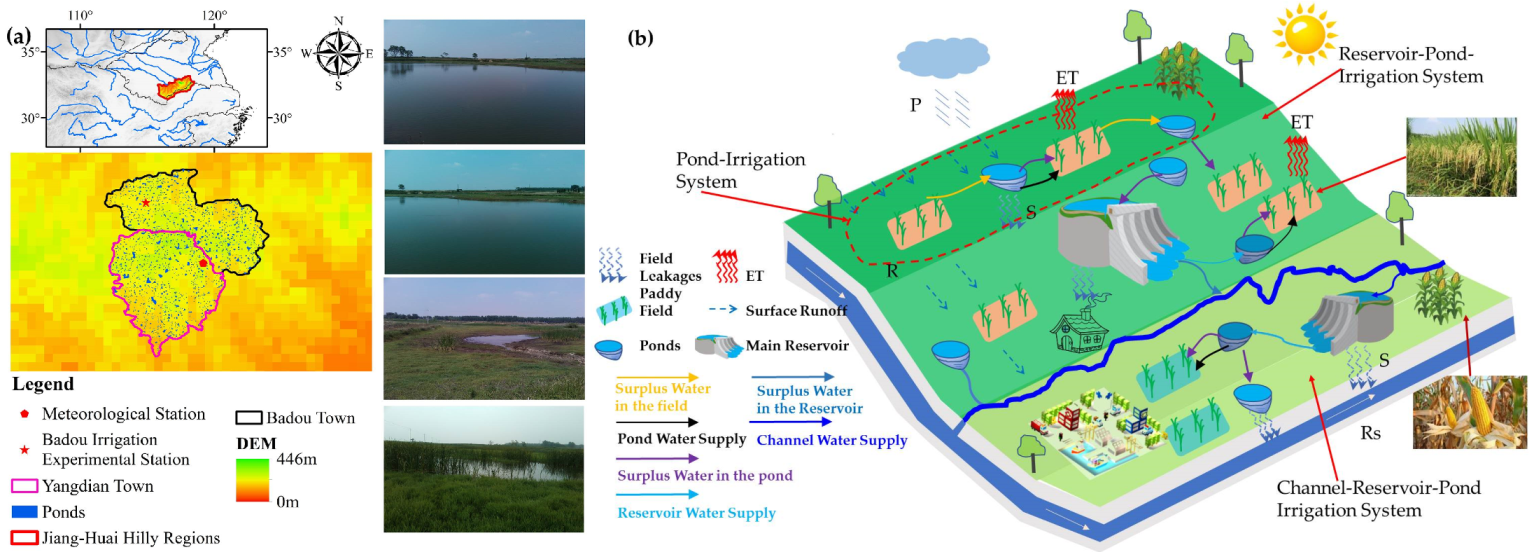
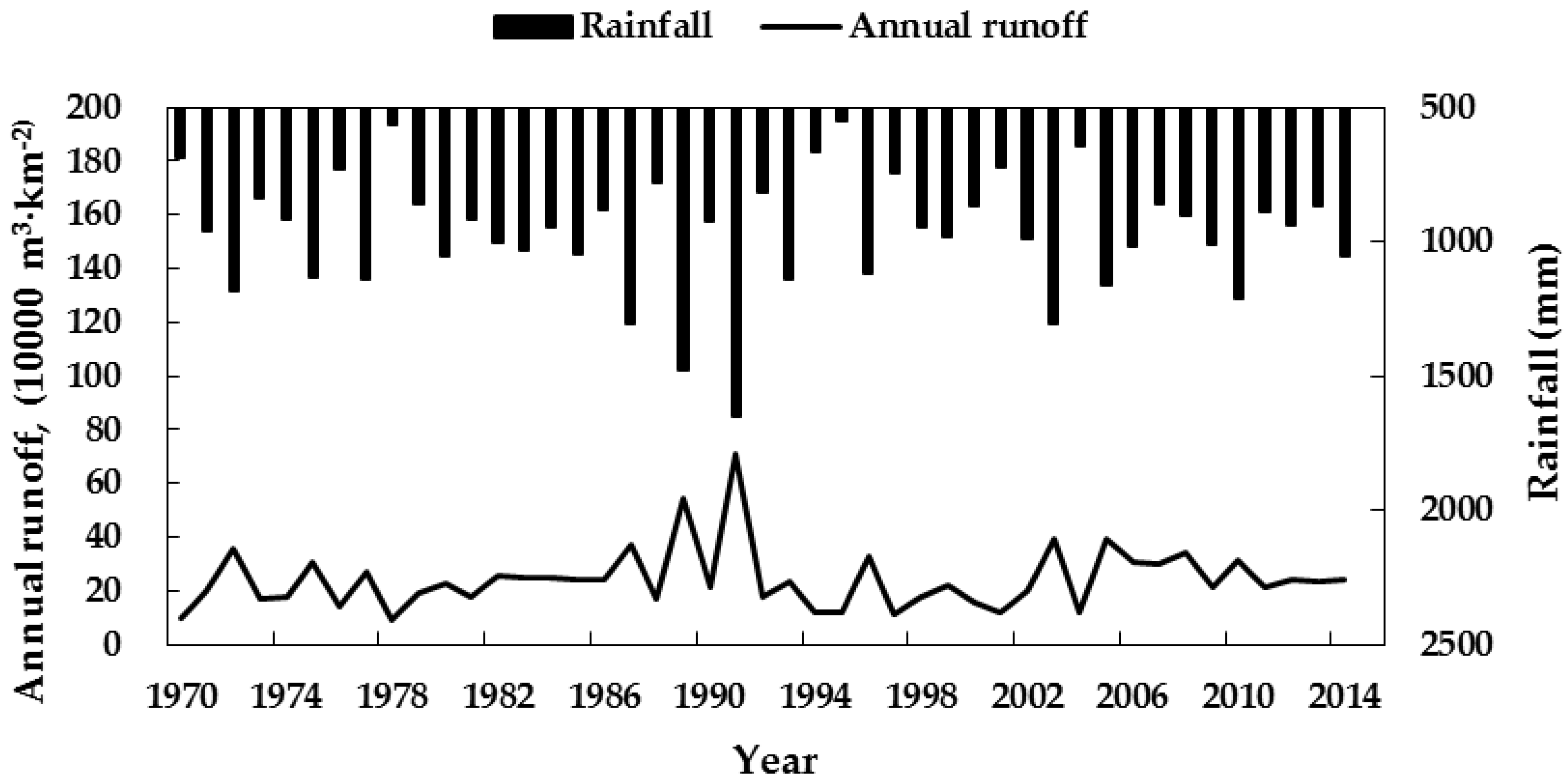
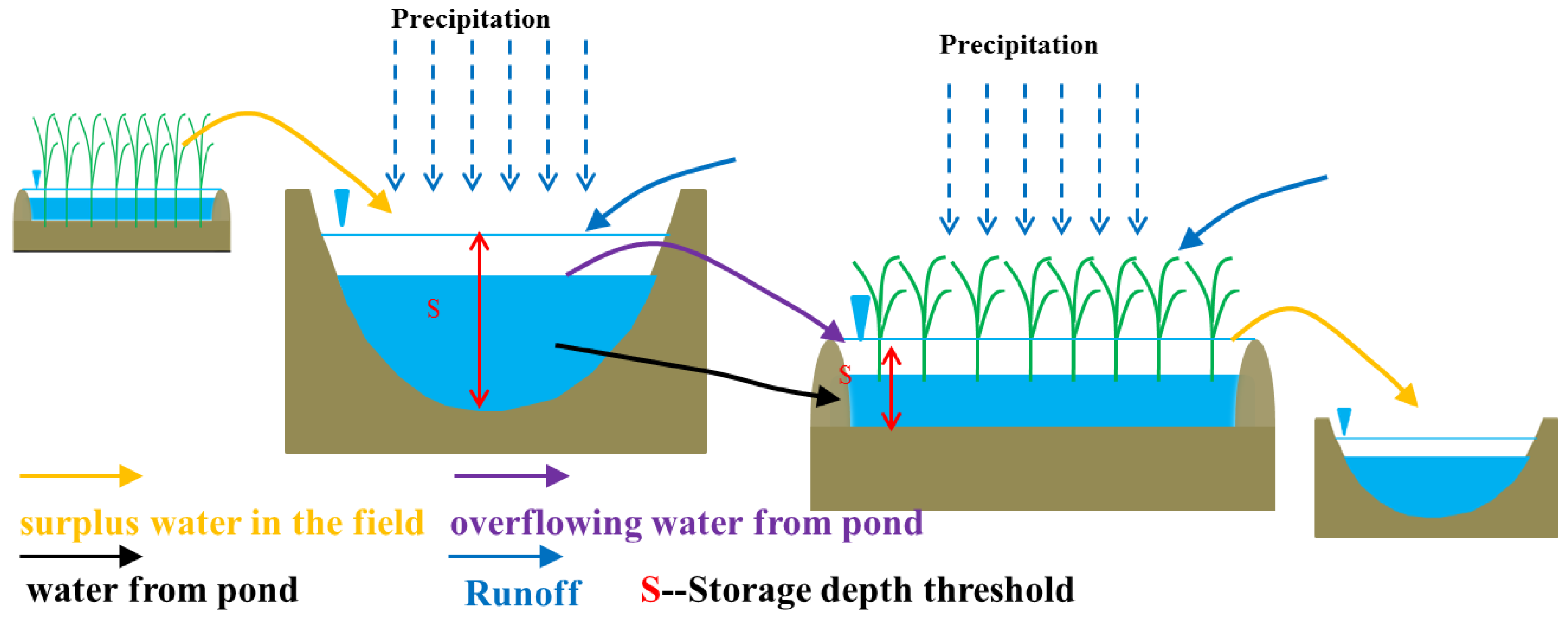
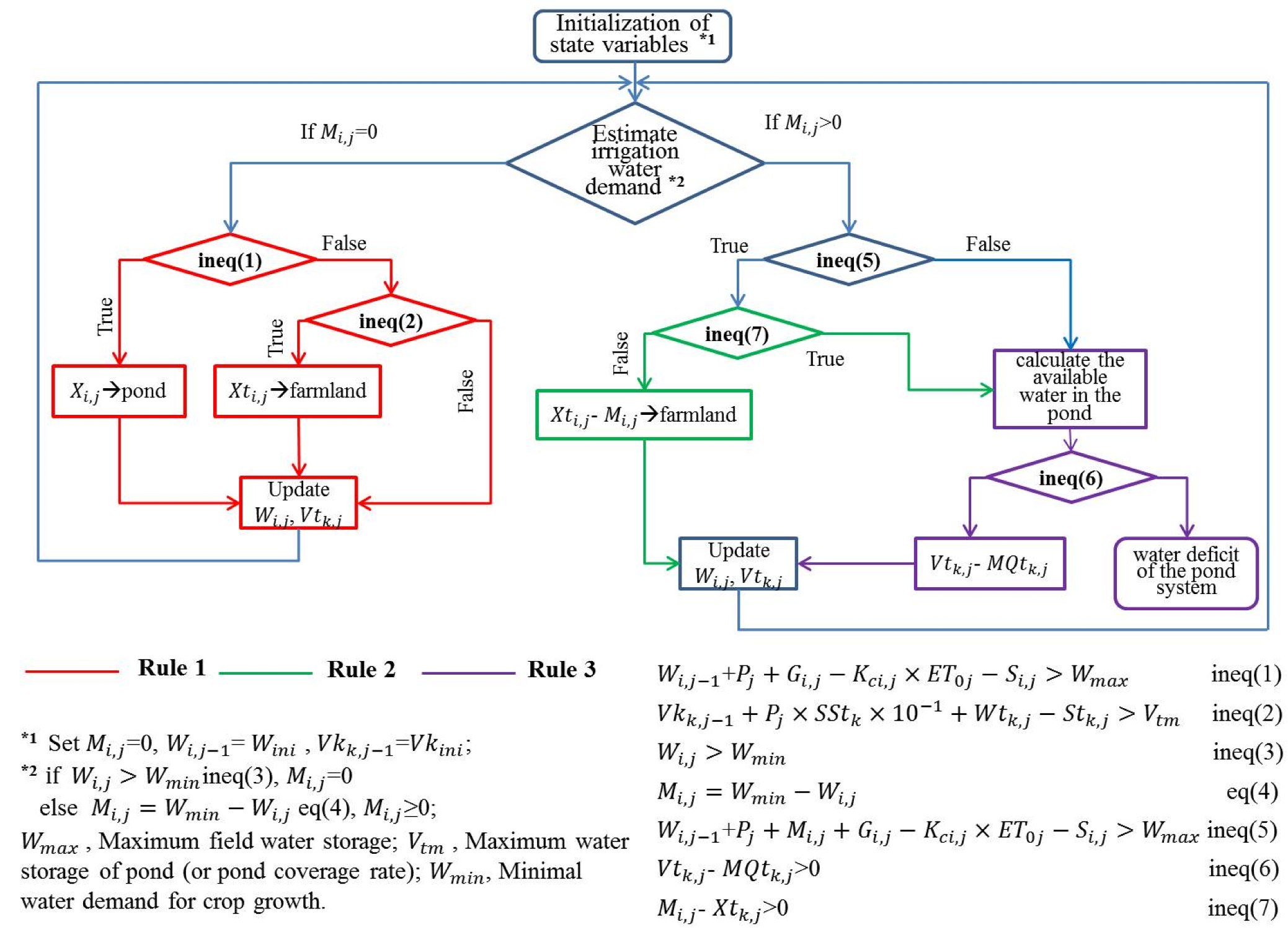
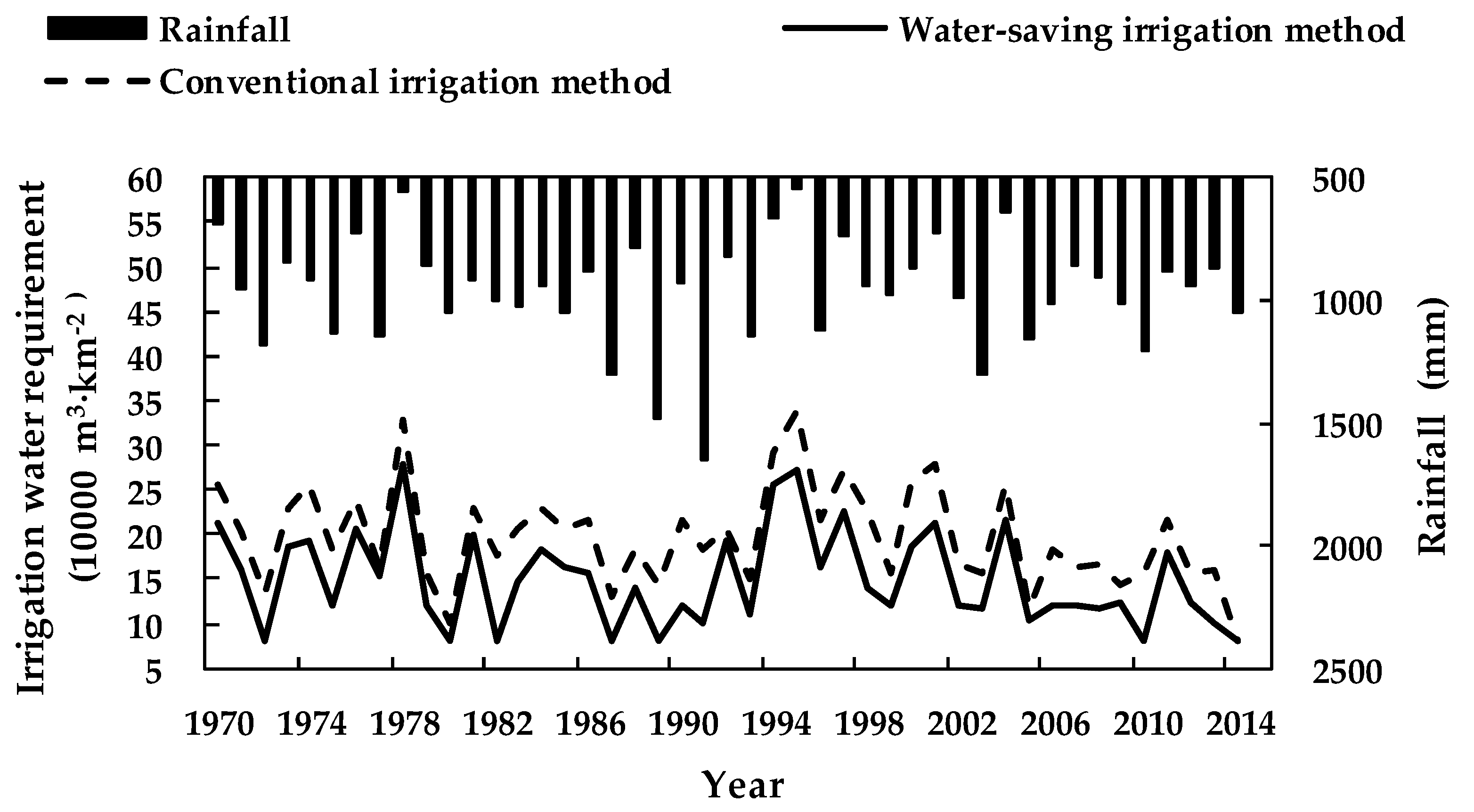
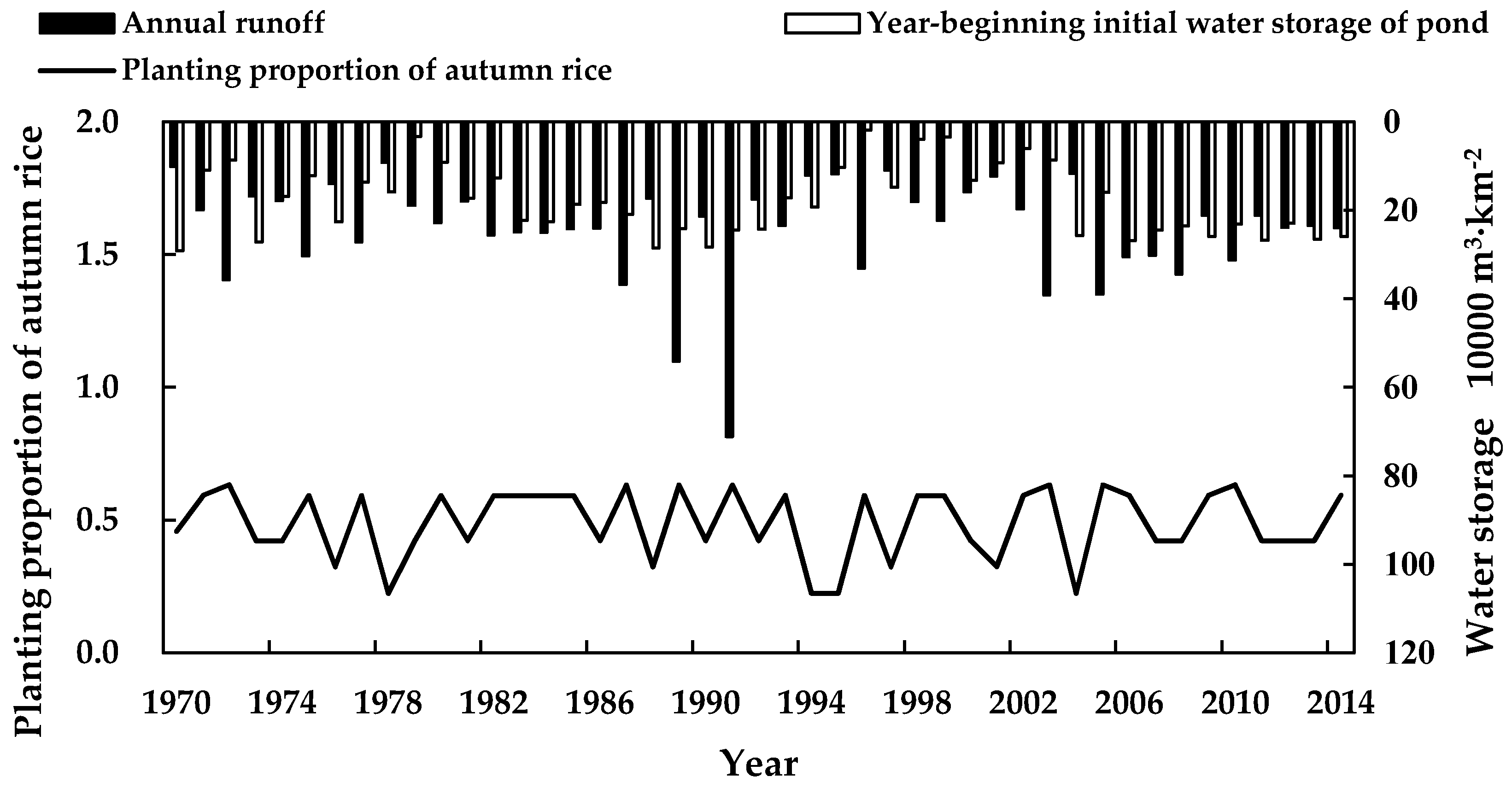
| Steps | Pseudo-Code of the Model Calculation Process |
|---|---|
| 1 | load the model inputs, which includes Daily Precipitation, Surface Runoff (calculated from SCS model) and Potential Evapotranspiration (calculated from PM formula) |
| 2 | Decide the maximal day without irrigation for different crop growth periods |
| 3 | Decide rainfall storage depth for different growth periods for the rice field |
| 4 | Calculate the daily actual evapotranspiration of crops |
| 5 | Field water balance calculation:
|
| 6 | Calculate the irrigation water consumption needed from pond by the result of step 5 and the effective utilization coefficient of farmland irrigation water |
| 7 | Pond water balance calculation:
|
| 8 | Calculate the average crop revenues, irrigation water requirement, pond water supply, water deficit and other objective function |
| Rainfall Frequency | Operation Mode | Irrigation Water Requirement (unit:*1) | Pond Water Supply (unit:*1) | Water Deficit (unit:*1) | Water Deficit Ratio (%) | Crop Revenue (unit:*2) |
|---|---|---|---|---|---|---|
| P < 20% | Conventional irrigation method | 14.50 | 13.71 | 0.79 | 6.67 | 176.07 |
| Water-saving irrigation method | 9.24 | 8.58 | 0.66 | 6.42 | 176.37 | |
| Water-saving effect | −5.26 | −5.13 | −0.13 | −0.26 | 0.30 | |
| 20% ≤ P < 50% | Conventional irrigation method | 17.42 | 15.10 | 2.32 | 12.43 | 172.48 |
| Water-saving irrigation method | 12.93 | 12.14 | 0.79 | 5.96 | 176.05 | |
| Water-saving effect | −4.48 | −2.95 | −1.53 | −6.47 | 3.57 | |
| 50% ≤ P < 75% | Conventional irrigation method | 20.28 | 16.04 | 4.23 | 19.61 | 167.70 |
| Water-saving irrigation method | 15.36 | 13.16 | 2.19 | 12.59 | 172.93 | |
| Water-saving effect | −4.92 | −2.88 | −2.04 | −7.02 | 5.23 | |
| 75% ≤ P < 90% | Conventional irrigation method | 24.38 | 14.18 | 10.20 | 38.79 | 149.59 |
| Water-saving irrigation method | 19.60 | 13.16 | 6.44 | 29.85 | 161.35 | |
| Water-saving effect | −4.79 | −1.02 | −3.77 | −8.94 | 11.76 | |
| P ≥ 90% | Conventional irrigation method | 29.39 | 68.01 | 15.79 | 52.48 | 134.22 |
| Water-saving irrigation method | 24.59 | 13.98 | 10.61 | 41.86 | 149.12 | |
| Water-saving effect | −4.80 | −54.03 | −5.18 | −10.62 | 14.90 | |
| Multi-year average | Conventional irrigation method | 19.74 | 14.91 | 4.83 | 20.40 | 165.37 |
| Water-saving irrigation method | 14.95 | 12.18 | 2.77 | 14.06 | 170.90 | |
| Water-saving effect | −4.79 | −2.73 | −2.06 | −6.34 | 5.53 |
| Rainfall Frequency | Operation Mode | Irrigation Water Requirement (unit:*1) | Surplus Water (unit:*1) | Water Deficit (unit:*1) | Water Deficit Ratio (%) | Crop Revenue (unit: *2) |
|---|---|---|---|---|---|---|
| P < 20% | Conventional irrigation method | 14.50 | 22.46 | 0.79 | 6.67 | 176.07 |
| Optimal regulation mode | 11.23 | 13.90 | 0.00 | 0.00 | 181.79 | |
| Optimal regulation effect | −3.27 | −8.56 | −0.79 | −6.67 | 5.72 | |
| 20% ≤ P < 50% | Conventional irrigation method | 17.42 | 4.94 | 2.32 | 12.43 | 172.48 |
| Optimal regulation mode | 14.60 | 0.51 | 0.38 | 2.53 | 179.52 | |
| Optimal regulation effect | -2.81 | -4.43 | -1.94 | -9.90 | 7.04 | |
| 50% ≤ P < 75% | Conventional irrigation method | 20.28 | 5.15 | 4.23 | 19.61 | 167.70 |
| Optimal regulation mode | 12.96 | 2.40 | 0.00 | 0.00 | 174.51 | |
| Optimal regulation effect | -7.32 | -2.75 | -4.23 | -19.61 | 6.81 | |
| 75% ≤ P < 90% | Conventional irrigation method | 24.38 | 1.84 | 10.20 | 38.79 | 149.59 |
| Optimal regulation mode | 14.05 | 0.35 | 0.47 | 3.15 | 170.01 | |
| Optimal regulation effect | −10.33 | −1.49 | −9.73 | −35.64 | 20.42 | |
| P ≥ 90% | Conventional irrigation method | 29.39 | 1.14 | 15.79 | 52.48 | 134.22 |
| Optimal regulation mode | 15.94 | 0.07 | 0.00 | 0.00 | 169.24 | |
| Optimal regulation effect | −13.45 | −1.07 | −15.79 | −52.48 | 35.02 | |
| Multi-year average | Conventional irrigation method | 19.74 | 7.03 | 4.83 | 20.40 | 165.37 |
| Optimal regulation mode | 13.70 | 3.08 | 0.18 | 1.18 | 176.44 | |
| Optimal regulation effect | −6.04 | −3.95 | −4.66 | −19.22 | 11.07 |
© 2019 by the authors. Licensee MDPI, Basel, Switzerland. This article is an open access article distributed under the terms and conditions of the Creative Commons Attribution (CC BY) license (http://creativecommons.org/licenses/by/4.0/).
Share and Cite
Jiang, S.; Ning, S.; Cao, X.; Jin, J.; Song, F.; Yuan, X.; Zhang, L.; Xu, X.; Udmale, P. Optimal Water Resources Regulation for the Pond Irrigation System Based on Simulation—A Case Study in Jiang-Huai Hilly Regions, China. Int. J. Environ. Res. Public Health 2019, 16, 2717. https://doi.org/10.3390/ijerph16152717
Jiang S, Ning S, Cao X, Jin J, Song F, Yuan X, Zhang L, Xu X, Udmale P. Optimal Water Resources Regulation for the Pond Irrigation System Based on Simulation—A Case Study in Jiang-Huai Hilly Regions, China. International Journal of Environmental Research and Public Health. 2019; 16(15):2717. https://doi.org/10.3390/ijerph16152717
Chicago/Turabian StyleJiang, Shangming, Shaowei Ning, Xiuqing Cao, Juliang Jin, Fan Song, Xianjiang Yuan, Lei Zhang, Xiaoyan Xu, and Parmeshwar Udmale. 2019. "Optimal Water Resources Regulation for the Pond Irrigation System Based on Simulation—A Case Study in Jiang-Huai Hilly Regions, China" International Journal of Environmental Research and Public Health 16, no. 15: 2717. https://doi.org/10.3390/ijerph16152717
APA StyleJiang, S., Ning, S., Cao, X., Jin, J., Song, F., Yuan, X., Zhang, L., Xu, X., & Udmale, P. (2019). Optimal Water Resources Regulation for the Pond Irrigation System Based on Simulation—A Case Study in Jiang-Huai Hilly Regions, China. International Journal of Environmental Research and Public Health, 16(15), 2717. https://doi.org/10.3390/ijerph16152717





